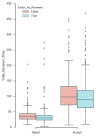The effects of an editor serving as one of the reviewers during the peer-review process
- PMID: 27508056
- PMCID: PMC4962294
- DOI: 10.12688/f1000research.8452.2
The effects of an editor serving as one of the reviewers during the peer-review process
Abstract
Background Publishing in scientific journals is one of the most important ways in which scientists disseminate research to their peers and to the wider public. Pre-publication peer review underpins this process, but peer review is subject to various criticisms and is under pressure from growth in the number of scientific publications. Methods Here we examine an element of the editorial process at eLife, in which the Reviewing Editor usually serves as one of the referees, to see what effect this has on decision times, decision type, and the number of citations. We analysed a dataset of 8,905 research submissions to eLife since June 2012, of which 2,747 were sent for peer review. This subset of 2747 papers was then analysed in detail. Results The Reviewing Editor serving as one of the peer reviewers results in faster decision times on average, with the time to final decision ten days faster for accepted submissions (n=1,405) and five days faster for papers that were rejected after peer review (n=1,099). Moreover, editors acting as reviewers had no effect on whether submissions were accepted or rejected, and a very small (but significant) effect on citation rates. Conclusions An important aspect of eLife's peer-review process is shown to be effective, given that decision times are faster when the Reviewing Editor serves as a reviewer. Other journals hoping to improve decision times could consider adopting a similar approach.
Keywords: decision times; eLife; peer review.
Conflict of interest statement
Figures




References
Grants and funding
LinkOut - more resources
Full Text Sources
Other Literature Sources

